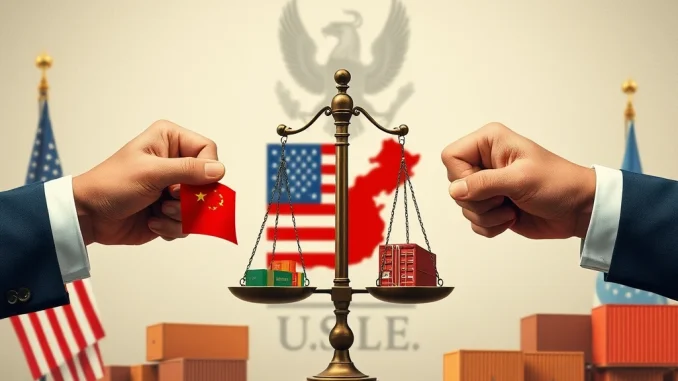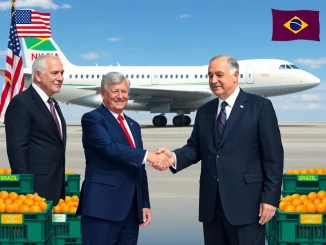
In the often-unpredictable world of global finance, ripples from government policy can quickly reach diverse markets, including cryptocurrency. That’s why recent comments from the U.S. Trade Representative regarding the potential expansion of Section 301 tariffs are catching the attention of those watching economic indicators closely.
What Exactly Are Section 301 Tariffs?
At its core, Section 301 of the Trade Act of 1974 is a powerful tool in the arsenal of U.S. trade policy. It authorizes the President to take all appropriate action, including imposing tariffs or other import restrictions, to address foreign unfair or discriminatory trade practices that burden or restrict U.S. commerce.
Think of it as a mechanism for the U.S. to unilaterally respond when it believes another country is playing unfairly on the global trade stage. It’s a significant provision because it allows for broad retaliatory measures without requiring specific approval from international bodies like the World Trade Organization (WTO), although its use can be controversial.
Why Is the USTR Talking About Expansion Now?
According to reports based on social media posts, Jamison Greer, the U.S. Trade Representative, indicated that the scope of Section 301 could be expanded if deemed necessary. This isn’t happening in a vacuum.
The context involves renewed focus on China trade relations. Former U.S. President Donald Trump recently stated that China had “completely violated” its prior tariff agreement with the U.S. While the specifics of this alleged violation aren’t detailed in the initial report, such statements from a prominent political figure, especially one who initiated significant trade actions against China, naturally draw attention to the tools available, like Section 301.
The mention by a current USTR official suggests that the administration is keeping its options open regarding trade enforcement, particularly concerning major trading partners.
Remember the Trade War? Section 301 Played a Role
This isn’t the first time Section 301 has been prominently featured in U.S. trade strategy. During the first Trump administration, Section 301 was the primary legal basis used to justify the imposition of substantial tariffs on a wide range of goods imported from China. This period was widely characterized as a trade war between the two economic giants.
That earlier episode demonstrated the potential scale and impact of Section 301 actions. It led to reciprocal tariffs from China, disrupted supply chains, affected various industries, and created significant uncertainty in global markets. The tariffs imposed then remain largely in place, making any discussion of *expanding* their scope or application particularly noteworthy.
Potential Implications of Expanded Tariffs
What could happen if the U.S. were to expand the scope of Section 301 tariffs? While speculative based on the brief report, potential outcomes could include:
- Increased Costs for Consumers and Businesses: Tariffs are taxes on imports. Expanded tariffs mean higher costs for imported goods, which can be passed on to consumers or absorbed by businesses, impacting profitability.
- Supply Chain Disruptions: Businesses reliant on imports from targeted countries would need to find alternative sources, potentially leading to delays and increased operational complexity.
- Retaliation: Countries targeted by expanded tariffs are likely to impose their own retaliatory measures on U.S. exports, harming American industries that sell abroad.
- Market Volatility: Heightened trade tensions historically lead to increased volatility in stock markets, commodity prices, and potentially currency exchange rates. This general market uncertainty can sometimes spill over into the cryptocurrency space, as investors react to the broader economic climate.
- Impact on Specific Sectors: The specific goods or sectors targeted by expanded tariffs would face direct pressure.
While the direct link between trade tariffs and cryptocurrency is indirect, global economic stability and geopolitical tensions are factors that influence overall market sentiment. Crypto markets, while often driven by unique factors, are not entirely immune to macro-economic shifts caused by significant events like a potential escalation of a trade war.
What Does This Mean for Those Watching Global Markets?
The statement from the USTR serves as a reminder that trade policy remains a dynamic and potentially disruptive force in the global economy. For investors, including those in the crypto space, it highlights the need to monitor geopolitical developments and government policy announcements.
While you don’t need to become a trade expert overnight, understanding that tools like Section 301 tariffs exist and can be deployed is important context. Pay attention to how these developments are discussed in broader financial news and how they might contribute to overall market sentiment and volatility.
In Summary
The U.S. Trade Representative’s comment about potentially expanding Section 301 tariffs underscores ongoing tensions in U.S. trade relations, particularly concerning China. Drawing on the precedent set during the previous trade war, this tool allows the U.S. to impose significant measures against perceived unfair practices. While the immediate trigger appears linked to recent comments about China trade agreements, any expansion could have widespread economic consequences, including disruptions to supply chains, increased costs, and potential retaliation.
For anyone navigating global markets, keeping an eye on statements from officials like the USTR regarding powerful tools like Section 301 is crucial, as these policies can create waves that reach far beyond specific imported goods, potentially influencing the broader economic climate that affects all asset classes, including digital ones.



